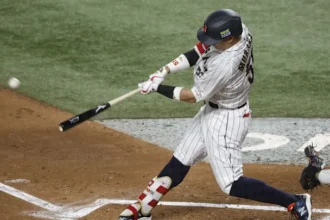The offseason has begun for all but a few teams still in the playoffs. It’s time to assess what they need to accomplish in the upcoming months. Next up is an evaluation of Buffalo.
This seemed like the year the Sabres would make a leap and reach the playoffs. They were bringing back most of one of the highest-scoring groups in the league and hoped Devon Levi would provide stability in goal. However, things didn’t go as planned.
Levi struggled early on and, while he remains a part of their long-term plans, he played more games in the AHL than the NHL. Additionally, they scored 50 fewer goals than in the 2022-23 season, dropping from the top three to outside the top 20, which led to them missing the playoffs again.

GM Kevyn Adams acted swiftly, rehiring Lindy Ruff as head coach to replace Don Granato, who was fired after the season. Nonetheless, there is still a lot of work to be done on the roster in the coming months.
Extension talks
Before addressing the necessary additions, let’s take a longer-term view. The Sabres have three key players who will become eligible for contract extensions on July 1 as they enter the final year of their current deals.
First, J-J Peterka made significant strides offensively this season, increasing his goal total from 12 in his rookie year to 28 and reaching the 50-point mark. If the Sabres believe he can improve even further in the 2024-25 season, it would be prudent to explore the cost of an early extension. Projecting continued improvement, a long-term deal would likely start at $5.5 million annually, if not more.
GM Kevyn Adams has a history of securing early extensions for key players, so it wouldn’t be surprising to see him investigate the potential cost of a long-term contract for the 22-year-old Peterka.
Jack Quinn is another forward in this situation, but his case is unique. Injuries limited him to just 27 games this season, though he was productive with 19 points and improved his per-game rates. With only 104 games played, a long-term extension might not be feasible. However, a bridge deal could provide Quinn with some security after an injury-riddled season and potentially offer Buffalo a favorable price if Quinn has a breakout year. A deal starting around $3 million annually might entice Quinn to sign now.
Then there’s Bowen Byram. He stayed healthy for most of the season and had a career year with 29 points in 73 games, logging nearly 22 minutes per game after being acquired from Colorado at the trade deadline for Casey Mittelstadt. Given what Buffalo sacrificed to get him, Byram is clearly in their long-term plans, and they will likely want to secure him sooner rather than later. Despite his injury history, his contract should surpass $6 million annually, though it won’t reach Owen Power’s $8.35 million. Notably, Byram is due a qualifying offer of $4.62 million next summer with arbitration rights, so Buffalo will need to present an attractive offer for an early agreement.
While it’s unlikely all three players will sign new deals over the summer, Adams will aim to gauge their contract expectations soon. This information will be crucial for planning the team’s summer spending.
Re-Sign Ukko-Pekka Luukkonen
While Devon Levi didn’t secure the starting goalie role, Buffalo received some good news between the pipes. Ukko-Pekka Luukkonen overcame a rough start and emerged as a reliable starter in the second half of the season, posting a .919 save percentage over 36 games after January 1. This performance kept the Sabres in playoff contention longer than expected.
Luukkonen’s timely improvement boosts his position as he approaches restricted free agency with arbitration eligibility. Midseason, he seemed unlikely to command a significant deal due to his backup status and inconsistent performance. However, his strong second half provides the 25-year-old with some leverage in negotiations.
This negotiation could take several paths. Given his 100 games of NHL experience, a long-term agreement seems unlikely. If Levi is still seen as the future starter, Buffalo might prefer not to lock Luukkonen into a lengthy deal. Additionally, Luukkonen is two years away from unrestricted free agency.
To avoid a contract that leads directly to free agency, Buffalo might opt for either a one-year deal or a medium-term pact that extends club control by a year or two. A one-year contract would likely be around $3.5 million. For a medium-term deal, Filip Gustavsson’s three-year, $3.75 million contract with Minnesota could serve as a benchmark, pushing Luukkonen’s price toward the $4 million range. Even when Levi becomes more expensive in 2025-26, Buffalo should be able to afford both goalies within this salary range.
Additionally, Buffalo will need to add a veteran goalie this summer. Since Levi still has waiver exemption, there might be times when they decide to give him a series of starts in the AHL with Rochester. Therefore, having a reliable third option would be beneficial. There will be several veteran goalies available in free agency who can provide dependable backup when needed.
Add a top-six winger
While there’s a case for avoiding any rash decisions despite the significant drop in scoring this season, and hoping that Ruff can reinvigorate their offense, Buffalo still needs to add, particularly on the wing. Although promising players like Jiri Kulich, Matthew Savoie, and Isak Rosen are on the rise, they could benefit from more time in the minors or a gradual introduction to the NHL.
Currently, the Sabres have around $65.5 million committed for next season, according to CapFriendly, assuming Levi returns full-time. With the remaining funds, they need to sign up to six forwards, a couple of defensemen (including Henri Jokiharju, who is due a $2.6 million qualifying offer), and Luukkonen. This puts them in one of the better cap situations in the league, giving GM Kevyn Adams enough room to make impactful moves.
Considering future contracts and potential salary increases for their 2025 RFAs, a top-market acquisition might not be the best strategy, as it could lead to a cap crunch. However, there are plenty of appealing options in the next tier of free agents, both for short-term and long-term solutions.
For shorter-term veterans, players like Jonathan Marchessault (if he doesn’t re-sign with Vegas), Vladimir Tarasenko, Tyler Toffoli, or Patrick Kane (a long-speculated target for Buffalo) could provide immediate scoring boosts. If the Sabres are looking for a longer-term addition, Teuvo Teravainen, Tyler Bertuzzi, or Jake DeBrusk could be viable options. These players would fit within Buffalo’s long-term salary structure while enhancing their forward group.
Adding one of these players, combined with some internal offensive improvement, could significantly bolster the Sabres next season.
Add center depth
For most of the season, Buffalo enjoyed strong center depth with Casey Mittelstadt joining Tage Thompson and Dylan Cozens. However, trading Mittelstadt for Bowen Byram created a need to fill that center spot. Peyton Krebs was given an extended opportunity to play center following the trade but managed just four goals all season. As a pending RFA, he’s worth retaining to see if head coach Lindy Ruff can help him rediscover his scoring touch from his junior hockey days.
The Sabres are also likely losing long-time player Zemgus Girgensons and Tyson Jost, both of whom played some center this season. Kyle Okposo, who also played center, was traded to Florida at the deadline. Internally, no centers from Rochester appear ready to compete for a roster spot in training camp, assuming Matthew Savoie needs more time in the minors. This means the Sabres need to fill at least one and likely two center positions.
With ample cap space, Buffalo has plenty of options. Depending on their decisions regarding the wing, they could have enough funds to pursue a quality third-line center. Sean Monahan could be a great addition to provide the depth they had with Mittelstadt. Chandler Stephenson would be a more expensive option but would offer similar benefits. Alexander Wennberg could also be a good fit as a third-line center who can step up if injuries occur.
Additionally, the Sabres might look to add a veteran fourth-line center. Due to their long-term rebuild and playoff drought, the team lacks veteran presence, and bringing in experienced players could be beneficial. This could also apply to the wing, where a short-term piece from free agency or the trade market could add stability and leadership.
At a minimum, the Sabres need to replenish their center depth, and they are expected to be aggressive in addressing this need over the next few months.





